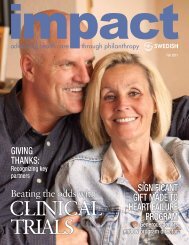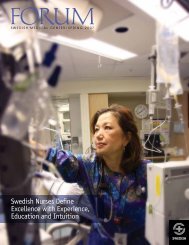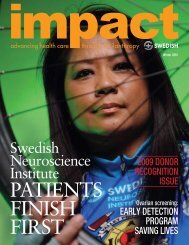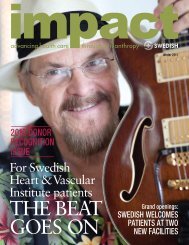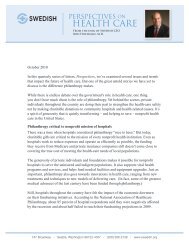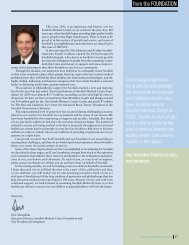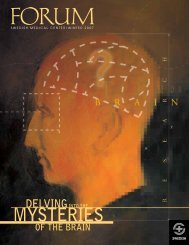Mysteries - Swedish Medical Center Foundation
Mysteries - Swedish Medical Center Foundation
Mysteries - Swedish Medical Center Foundation
- No tags were found...
Create successful ePaper yourself
Turn your PDF publications into a flip-book with our unique Google optimized e-Paper software.
S W E D I S H M E D I C A L C E N T E R \ W I N T E R 2 0 0 7Delving into the<strong>Mysteries</strong>of the Brain
O N T H E C O V E RMapping the brain. Reading genetic markers.Navigating with GPS-like systems.The stunning advances in the neurosciences have meant new life and newhope for millions of people with neurological diseases and disorders.Yet the human brain still holds vast mysteries. For many, the keys tounlocking them have yet to be found. But we are getting closer.The researchers and physicians at the <strong>Swedish</strong> Neuroscience Institute arecommitted to unlocking these mysteries. <strong>Swedish</strong> now has one of the largestbrain tumor research projects in the country. Through close collaborationwith other renowned experts in the region, researchers strive to find the curefor a host of diseases.For information on how you can help, contact the<strong>Swedish</strong> <strong>Medical</strong> <strong>Center</strong> <strong>Foundation</strong> at 206-386-2738.Cover art by M. Durrant
There was a time in health care when any hospitalcould say it delivers quality health care, and no onewould question it. But times have changed, and intoday’s world, you can’t just claim to do quality work – you haveto prove it.The physicians, nurses and other clinical staff at <strong>Swedish</strong> aredoing just that. By following proven clinical processes, they areworking to do things right the first time, every time. It’s part of our commitmentto quality, and it’s the reason we signed on to participate in the national 100,000lives campaign to reduce medical errors in hospitals.Recently, our work in this area was featured in a PBS series titled “TheRemaking of American Medicine.” The documentary showcased our qualityimprovement initiatives and captured the passion and dedication our staff hasfor this work. It is a moving and inspiring piece, and I am honored that PBSthought our story worth sharing at a national level.<strong>Swedish</strong> is also working to improve quality by replacing paper patient recordswith a secure electronic medical record. With our new state-of-the-art clinicalinformation system, our staff will have vital patient information at their fingertips,which is especially critical when they need to make immediate, life-savingdecisions. The new system – a $120 million investment for <strong>Swedish</strong> – will go livein phases beginning in 2007, and much work is taking place behind the scenes tomake it a success.Whether we are pursuing clinical research or continuous quality improvement,our work would not be possible without the generosity of donors like you.As I prepare for my upcoming retirement and reflect on my tenure here, I wantto thank you for your ongoing support of our nonprofit mission.I wish you all the very best in the new year.Richard H. PetersonPresident and Chief Executive Officer
F O R U MWINTER 2007T a b l e o f C o n t e n t sC A P S U L E SVolume 21, Issue IRichard Peterson to Leave Lasting Legacy................................... 1Melissa TizonDirector, CommunicationsEditor:Janet SimmelinkF E A T U R EFinding the Key to Unlock the <strong>Mysteries</strong> of Brain Tumors....... 4Designer:Mike DurrantProduction Team:Amanda HolmNatalie KozimorFeature Writer:Janice KennedyFeature Photographer:Doug OgleF O U N D A T I O N N E W SThe Merrill P. Spencer, M.D., Endowed Lecture....................... 12Giving Back to Ballard.................................................................... 13<strong>Swedish</strong>’s Founders Circle: The Legacy Continues................... 14Around the World in One Spectacular Night........................... 14Welcome to <strong>Swedish</strong> <strong>Medical</strong> <strong>Center</strong>’s FORUMmagazine. This publication is designed to provideyou with the latest information about <strong>Swedish</strong>services and events, health-care and medicaltopics, and the activities of the <strong>Swedish</strong> <strong>Medical</strong><strong>Center</strong> <strong>Foundation</strong> and its supporters. FORUMis published as a community service by <strong>Swedish</strong><strong>Medical</strong> <strong>Center</strong>. Any questions or commentsmay be addressed to Janet Simmelink, editor,<strong>Swedish</strong> <strong>Medical</strong> <strong>Center</strong>, 747 Broadway, Seattle,WA 98122-4307.
C A P S U L E SRichard Peterson to Leave Lasting LegacyWhen Richard H. Peterson took thehelm as president and CEO of<strong>Swedish</strong> in 1995, he could not havearrived at a bleaker time.It was the era of health-care reform,and <strong>Swedish</strong> was recuperating from aseries of blows: its first financial losses inhistory, hundreds of layoffs, and a bitter,very public labor dispute with the unionrepresenting its nurses. <strong>Swedish</strong> was alsoon the verge of merging into TacomabasedMulticare Health System.The merger, of course, never came tobe because, upon his arrival, Peterson andthe Board of Trustees made a decisionto call it off and, instead, focus on turning<strong>Swedish</strong> around. That’s exactly whatPeterson did, and within a short time, theinstitution was back on solid ground.The rest, as they say, is history, with theorganization growing and expanding foranother decade.“Today, <strong>Swedish</strong> is not only larger, it isstronger, healthier and well positionedto serve the community for many moreyears to come,” says <strong>Swedish</strong> Board ofTrustees chair Kirby McDonald.“We could not have come this farwithout Richard’s leadership and commitmentto our nonprofit mission. Ashe prepares for retirement, we owe himmany thanks for making <strong>Swedish</strong> what itis today.”Peterson, 64, will retire early this year,marking the end of a dynamic chapter inthe history of the organization.A period of growthPeterson will leave the organizationwith many accomplishments behind him.He presided over a period of tremendousgrowth that included the constructionof the 11-story East Tower on the FirstHill campus, the addition of ProvidenceSeattle <strong>Medical</strong> <strong>Center</strong> to the <strong>Swedish</strong>system in 2000 and the opening of a freestandingEmergency Room and Specialty<strong>Center</strong> in Issaquah in 2005.He also pushed to redefine <strong>Swedish</strong>as a collection of core specialty services,rather than the traditional collectionof hospitals. What emerged were dedicatedcenters of excellence, such as theconstruction of the <strong>Swedish</strong> CancerInstitute in 2001 and, more recently, the<strong>Swedish</strong> Heart & Vascular Institute andthe <strong>Swedish</strong> Neuroscience Institute.A groundbreaking for the <strong>Swedish</strong>Orthopedic Institute is set for earlyJanuary.F O R U MW I N T E R 2 0 0 71
C A P S U L E SThe pursuit of qualityA passionate advocate for qualitythroughout his career, Peterson madeit a major focus at <strong>Swedish</strong>. The organization’squality-improvement work hasbeen recognized with several prestigioushonors, including of the Leadership Levelof the Washington State Quality Award,the Codman Award for excellence instroke care and the 2007 Health GradesAward. Additionally, for nine years,local consumers have named <strong>Swedish</strong>the hospital with the best overall qualityaccording to an annual survey done bythe National Research Corp.“Quality is critically important toRichard. He has pushed the organizationto be the best it can be and has been astrong champion of quality improvement,”says <strong>Swedish</strong> outgoing chief of staffJohn Vassall, M.D.He has also been a supporter of continuouslearning and improvement andmade ongoing education and trainingpart of the culture at <strong>Swedish</strong>. One ofhis lasting legacies will be the creation ofa dedicated education and conferencecenter that will help managers, staff andphysicians at <strong>Swedish</strong> develop and learnnew skills.Serving the communityAnother one of his passions has beenthe issue of access to emergency healthcare. To increase access, he established a“no divert” policy that essentially meansno matter how busy they are, the <strong>Swedish</strong>emergency departments will alwaysaccept ambulance patients.By the same token, Peterson is proudthat the level of charity care providedby <strong>Swedish</strong> grew from $5 million peryear when he started to more than$13.3 million per year at the end of histenure. He is also proud that the annualCelebrate <strong>Swedish</strong> gala has gone fromraising $300,000 per year for charity careto more than $1 million per year. Heand his wife, Rosemary, are also activelyinvolved in the community. He serves onboards for United Way of King County,the Seattle Chamber of Commerce andLife <strong>Center</strong> Northwest.Rosemary is a member ofSeattle University’s Dean’sAdvisory Board and theSeattle Opera Board.CollaborationAmidst the competitiveenvironment of healthcare,Peterson soughtways to collaborate withothers whenever possible.Through partnershipswith community hospitals– such as Northwest,Stevens, Valley andHighline – <strong>Swedish</strong> has been able to makeits cancer- and heart-care services availablein local communities.Likewise, Peterson found innovativeways to partner with physicians. <strong>Swedish</strong>became the first to develop hospital-physicianjoint ventures on services such asmedical imaging and ambulatory surgery.He also formed a productive relationshipwith the labor unions at <strong>Swedish</strong> and,under his leadership, four nursing contractswere successfully negotiated.A solid foundationLike all hospital administrators,Peterson has had to navigate the complexand often turbulent waters of the healthcareindustry and, like his peers nationwide,his decisions have not always beenpopular.“Not everyone has agreed with himall of the time. But as a strong leader, he’smade tough decisions and stuck withthem. Ultimately that is the job of leadership,and thoughtful people admire himfor that,” says Dr. Vassall.Richard and Rosemary Peterson received the 2006John A. Soderberg Sr. Lifetime Achievement Award in Octoberfrom the <strong>Swedish</strong> <strong>Medical</strong> <strong>Center</strong> <strong>Foundation</strong>.During his tenure, Peterson assembleda senior leadership team to operate anddevelop different aspects of the organization.His administration will be rememberedfor working tirelessly on manyfronts, with the ultimate goals of making<strong>Swedish</strong> the best place to receive care,and the best place to work and practicemedicine.Though a successor had not yet beennamed when this issue of FORUM wentto print, the next generation of leadershipwill have a solid foundation to build upon.After all, Peterson is leaving the organizationin far better shape than he found it 12years ago.F O R U M2W I N T E R 2 0 0 7
C A P S U L E SRichard H. PetersonRole: President and CEOTenure: 1995-2007Sept. 2005Sept. 2005<strong>Swedish</strong> receives the Leadership Level of the Washington StateQuality Award<strong>Swedish</strong> prepares to implement clinical information systemMilestonesJan. 1995 Peterson takes officeFeb. 1996 Lobby & main entrance open on BroadwayJan. 1997 Women & Infants <strong>Center</strong> opens on First HillApr. 1998 <strong>Swedish</strong> rolls out mission-vision-values statementApr. 1998 Construction begins on East Tower on First HillJul. 2000 Providence Seattle <strong>Medical</strong> <strong>Center</strong> joins <strong>Swedish</strong> systemJan. 2002 <strong>Swedish</strong> Cancer Institute celebrates grand openingJan. 2002 Sabey Corp. purchases part of Prov campus, including the 1910Building and the Jefferson TowerMay 2004 <strong>Swedish</strong> sells various medical-office buildings to HCPIMar. 2005 $20 million Emergency Department and Specialty <strong>Center</strong> opensin Issaquah, with imaging services provided through a jointventure with Radia ImagingOct. 2005 Construction begins on $30 million <strong>Swedish</strong> NeuroscienceInstituteNov. 2005 <strong>Swedish</strong> receives Earnest A. Codman Award for stroke careJan. 2006 PET/CT Imaging <strong>Center</strong> opens as a <strong>Swedish</strong> joint venturewith Seattle Nuclear Medicine and Tumor Institute RadiationOncology GroupJan. 2006 <strong>Swedish</strong> launches its first TV ad campaign, “Living the Oath”Sept. 2006<strong>Swedish</strong> receives Health Grades AwardOct. 2006 Peterson and wife, Rosemary, presented with LifetimeAchievement AwardNov. 2006 <strong>Swedish</strong> Heart & Vascular Institute celebrates grand openingNov. 2006 <strong>Swedish</strong> becomes a smoke-free facilityJan. 2007 <strong>Swedish</strong> Orthopedic Institute celebrates groundbreakingEarly 2007Early 2007New education center opensPeterson to retire<strong>Swedish</strong> Then & Now1995 2005151050$5Million$13.3Million121086420$5.3Million$11.1Million10987654321$307Million$1 Billion131211109876543210 08601,245CHARITY CAREPHILANTHROPIC GIFTSTO SWEDISHREVENUE BASELICENSED BEDSF O R U MW I N T E R 2 0 0 73
FINDING THE KEYTO UNLOCK THEMYSTERIESOF BRAIN TUMORSOn Dec. 30, 2005,Lori Top awoketo find herhusband, John, in the throes ofa massive seizure. Although hisspasms stopped a few minuteslater, he could not move anddidn’t seem to recognize Lorior her parents, whom theywere visiting in Kansas City.Paramedics arrived to providehelp, but John looked atthem “as if they were aliens,”remembers Lori.F O R U M4W I N T E R 2 0 0 7
F O R U MW I N T E R 2 0 0 75
As Lori rode with John in the ambulance, a smallmiracle seemed to take place. Lori watched asJohn seemed to recover. He even apologized to theparamedics for getting them out in the middle of acold night. At the hospital, however, the news was not good.A CT scan revealed a “spot” on John’s brain. The emergencyroom physician said this was evidence of “maybe a stroke,maybe a bruise on the brain . . . maybe something else.”That “something else,” they soon learned, was the mostdevastating news of all. John, a man who had never been illin his life, had a malignant cancerous tumor in his brain.The Tops returned home to Seattle. As John tried toresume his life and work, Lori researched treatment optionswith mounting despair. One physician the couple consultedsuggested it might be best to forego any treatment andmake the best of the time they had.Eventually, the Tops found themselves at the <strong>Swedish</strong>Neuroscience Institute. And there they met a neurosurgeonwho would not only offer excellent medical care, but alsosomething they were finding in short supply — hope.A Physician Focused on aFuture for His PatientsGreg Foltz, M.D., is a quietly determined man. Whenhe meets patients like John Top, his goal is not only totreat the symptoms of their disease, but also to keepthem alive long enough for medical science to find acure. And he’s not sitting by waiting for that to happen. Dr.Foltz recently helped set up what may be the country’s mostcomprehensive brain tumor bank to catalog and studytumors like John’s. The information researchers hope togain may well pave the way for cures for a host of diseases,not just those of the brain.F O R U M6W I N T E R 2 0 0 7
It was the opportunity to be both a hands-onneurosurgeon and a researcher that brought Dr. Foltz to the<strong>Swedish</strong> Neuroscience Institute (SNI) in 2005. Previously,Dr. Foltz had been at the University of Iowa College ofMedicine, where his clinical interests included the surgicaltreatment of malignantbrain tumors, but alsocomplex disordersof the craniocervicaljunction — the placewhere the spine andbrain attach.Relocating to<strong>Swedish</strong> meant Dr.Foltz could see andstudy more patientswith the kind oftumors he wanted tofocus on treating. As the premier treatment center in thePacific Northwest for complex tumors of the brain, the SNIwelcomes patients from around the world.“One thing that makes learning about these types oftumors difficult,” says Dr. Foltz, “is that there are relativelyfew people who get them.” Dr. Foltz is especially interestedin oligodendrogliomas like John’s, which are currentlyconsidered incurable.Soon after arriving in Seattle, Dr. Foltz began working ondeveloping a tumor “bank” that would give researchers inSeattle and beyond access to tissue samples for advancedstudy. In 2006 he was able to meet this goal through analliance with the Allen Institute for Brain Science and theInstitute for Systems Biology, both premier Northwestresearch institutions.“We now have oneof the largest braintumor researchprojects in thecountry,” says Dr.Foltz. “I can now tellmy patients that wehave people workingevery day for a betterunderstanding ofthese tumors.”“We now have one of the largest brain tumor researchprojects in the country,” says Dr. Foltz. “I can now tell mypatients that we have people working every day for a betterunderstanding of these tumors.”What is unusual about the research project, says Dr.Foltz, is that the collaborators are focused solely on humandisease rather than theoretical pursuits. It is a project witha mission, says Dr. Foltz, to help patients currently affected.It is from these patients’ tumors that all of the data iscollected.One of the things the researchers are looking into iswhether there are certain genes that “turn on” and causea tumor to grow. These genes may remain dormant fordecades, only to “awaken” for some reason. Why? That’swhat researchers are hoping to find out.Dr. Foltz has also developed a way to analyze a patient’sblood and look for certain “markers” that can helpdetermine the best course of chemotherapy for a particulartype of tumor. While there is still a long way to go, the earlyresults look promising for not only brain tumors, but othertypes of diseases as well. The goal is to eventually learnwhich drugs will best destroy a particular tumor withoutharming healthy tissue or impacting vital organs.F O R U MW I N T E R 2 0 0 77
Treating the Patient,Not Just the DiseaseIn researching treatment options, Lori Top met withmedical personnel at other facilities that seemeddetached and uninterested in the traumatic impactJohn’s condition was having on their lives. She says shewas pleasantly surprised by John’s first visit with Dr. Foltz.“He asked John about his life. He made it clear,” she says,“that he wanted to treat John the person and not just thetumor.” John told him about his work as an architect, abouthis and Lori’s daughter, Isabelle, who was 6, and about hisdaughter, Katie, who was 12 and lived with the couplepart of the year. He told Dr. Foltz he wasn’t ready to leavethem behind.After assessing John’s condition, Dr. Foltz recommendedan operation to take out as much of the mass as possible.Because the tumor was in the brain’s right frontal lobe,which controls function on the left side of the body, Dr.Foltz believed John would retain most of his abilities sincehe was right-handed. Removing the tumor, however, wouldamount to taking almost a quarter of John’s brain and withthat came such risks as a change in personality. There wasno way to know for sure. Dr. Foltz encouraged the couple toget a second opinion.Their visit to another facility for that purpose, says Lori,began with a three-hour wait to see a doctor and endedwith her “leaving the exam room in tears.” The secondopinionphysician told the couple that John would soon bedead “regardless of what we did.” The next visit to Dr. Foltz,however, renewed their commitment to fight. They gavehim the go-ahead to develop a plan for surgery and followuptreatment.On Jan. 25, 2006, Dr. Foltz performed a craniotomyon John that removed the tumor and allowed for a morecomplete diagnosis of the disease and its prognosis. Lori’sfears about a personality change in John were abated whenshe realized as he recovered that his “dry sense of humorcame through unscathed.”The subsequent pathology report specified John’s tumoras an “oligodendroglioma,” grade three. It was both goodnews and bad. John could expect to live two or more yearscompared to three to six months with other types of braincancers. But while subsequent assessments have foundJohn to be “cancer free for the moment,” the disease is stillexpected to return and take his life.“Today, I live with the fact that I have a terminal illness,”says John, who has continued to work throughout hisordeal of the past year. “I actually feel blessed,” he sayswith a small laugh. “I don’t sit around now. I get out and dothings. If Lori and Isabelle want to go for a walk, we go fora walk. We appreciate the time we have together, no matterwhat we’re doing.”John calls Lori his hero. “She’s cried with me and she’salso told me to pull it together and keep going.”Lori, also an architect, recently went back to work as astore designer to help meet the family’s growing expenses.For his part, John took sick leave and vacation time for histreatments that came to only a little over 100 hours.“I got brain cancer,” he says, “I didn’t win the lottery. Lifegoes on and it’s a good life. I’m grateful for all that we have.”Dr. Foltz says the recent establishment of the brain tumortissue bank is one thing that keeps him positive as he worksevery day with patients like John who face terminal illness.“It gives me a lot of hope as a doctor,” he says, “and that’swhy I can do the work I do. Because I have hope.”F O R U M8W I N T E R 2 0 0 7
F O R U MW I N T E R 2 0 0 79
Cooperative Effortto Learn MoreAbout Brain DiseasesThe <strong>Swedish</strong> Neuroscience Institute has joined forceswith the Allen Institute for Brain Science and theInstitute for Systems Biology to collaborate on researchthey hope will lead to cures for diseases of the brain.The alliance brings together physicians and researchersfrom three of the most respected organizations in thePacific Northwest.The <strong>Swedish</strong> Neuroscience Institute (SNI) is led by twoof the region’s top neurosurgeons – Executive DirectorMarc Mayberg, M.D., and Executive Director and <strong>Medical</strong>Director David Newell, M.D.In addition to being the principal investigators on manyclinical trials and the authors of hundreds of scientificpapers, Drs. Mayberg and Newell head an exceptional teamof SNI neurologists, neurosurgeons and subspecialists.The Allen Institute for Brain Science was founded in2001 with a $100 million grant from philanthropist andMicrosoft co-founder Paul G. Allen. In September, theinstitute completed the Allen Brain Atlas, a Web-based,“Systems biologyis the scienceof discovering,modeling,understandingand ultimatelyengineering atthe molecularlevel the dynamicrelationshipsbetween thebiologicalmolecules thatdefine livingorganisms.”Leroy Hood, M.D.three-dimensional map ofgene expression in the mousebrain. Detailing more than21,000 genes at the cellularlevel, the atlas providesscientists with a level of datapreviously not available.“We’re now ready to takethis powerful tool to the nextlevel,” says Allan Jones, thebrain institute’s chief scientificofficer. “Dr. Greg Foltz andhis team at the <strong>Swedish</strong>Neuroscience Institute, whoare already conducting vitalresearch, will be a criticalpartner in that work.”This image is of the Allen Brain Explorer, a free and publicly availableapplication that allows scientists to view 3-D representations of geneexpression data from the Allen Brain Atlas. (Courtesy of the Allen Institutefor Brain Science)The third partner in the new collaborative research effortis the Institute for Systems Biology (ISB). Founded in 2000,the ISB integrates such sciences as biology, chemistry,physics, computation, mathematics and medicine.“Systems biology is the science of discovering, modeling,understanding and ultimately engineering at the molecularlevel the dynamic relationships between the biologicalmolecules that define living organisms,” says Leroy Hood,M.D., ISB co-founder and president. Unlocking the keys tothose dynamic relationships may provide answers to howillness and disease work in the human brain.The new partnership between the <strong>Swedish</strong> NeuroscienceInstitute, the Allen Institute for Brain Science and theInstitute for Systems Biology represents “the future ofmedicine,” says SNI’s Greg Foltz, M.D. Already underwayis a research project in which brain tumor samples from<strong>Swedish</strong> patients are being preserved and studied bypartner scientists with the aim of learning how the growthof these tumors might be slowed or stopped.“As a physician whose primary concern is my patients,”says Dr. Foltz, “it’s inspiring to see scientists working sohard to find a way to help them.”F O R U M10W I N T E R 2 0 0 7
<strong>Swedish</strong> Neuroscience InstituteProvides Northwest PatientsWith World-Class TreatmentWhen her husband, John, had a seizure in Kansas Cityand physicians suspected a brain disorder, Lori Topdid a computer search to find out what resourceswould be available when they returned home toSeattle. That’s when she learned about the <strong>Swedish</strong>Neuroscience Institute (SNI), where John became a patientof neurosurgeon Greg Foltz, M.D., in early 2006.Lori will be, she says, “forever grateful” for finding a placeand a physician who provided John with “the best of care”during a difficult time for her family.SNI’s surgical, diagnostic and therapeutic capabilitiesare among the most comprehensive in the country.They include:• GPS-like guidance systems that help surgeons navigate incritical areas of the brain during operations• MRI and CT scanners and 3-D angiography that providereal-time images during operationsWhile there are many high-tech advantages to beingcared for at SNI, Dr. Foltz says he and other staff membersbelieve the most important aspect of care is the patient’swell-being and comfort. “I’m here because I want topractice medicine and do research in a place that is patientcentered above all else,” he states.SNI staff members are also involved in active researchprojects that will benefit patients. One current projectmay lead to the development of a simple blood test thatwill confirm the presence of brain tumors long before theybecome clinically significant. Other research is looking intogenetic markers that can help physicians select the bestmethods for treating brain diseases and other disorders.More information about the <strong>Swedish</strong> NeuroscienceInstitute is available at www.swedish.org or by calling206-320-4144 or 1-800-331-1733.• Brain-mapping capabilities to identify areas of criticalbrain function• Interventional neuroradiology techniques to block bloodflow to tumors prior to surgeryCyberKnife Offers Advanced Treatment OptionOne goal of SNI patient care is to minimize trauma and shortenrecovery times associated with surgery. Options for patientsnow include surgical techniques that employ smaller incisionsthan normal as well as operations that require minimaluse of anesthesia. Some SNI patients can also benefit from“CyberKnife,” a new radiosurgery procedure that focusesmultiple, intersecting beams of radiation to a precisely targetedarea with sub-millimeter accuracy, dramatically reducingdamage to the healthy tissue surrounding a tumor.F O R U MW I N T E R 2 0 0 711
F O U N D A T I O N N E W SPerpetuating Excellence: The Merrill P. Spencer, M.D., Endowed LectureBy measuring the ultrasound waves as theybounce back to a hand-held device, a computercan measure blood-flow velocity – and determineif there are blood clots present in the vessels.Thanks to a newly endowed lectureship,the <strong>Swedish</strong> Neuroscience Institutewill be able to continue bringingnationally renowned experts to Seattleto share their expertise with the medicalcommunity here. The annual Merrill P.Spencer, M.D., Endowed Lectureship willfocus on the latest innovations in vascularand neuro-related medicine.Dr. Spencer, who passed away recently,was a world leader in medical ultrasound.The endowment established in his honorwill cover the costs of the annual lecture,now offered through the Continuing<strong>Medical</strong> Education program, which helpstrain medical professionals throughoutthe region.With a long and distinguished careeras a physician, professor, researcher andinnovator, Dr. Spencer earned an internationalreputation for his groundbreakingwork with Doppler ultrasound technology.Among his many accomplishments,he founded the Institute of AppliedPhysiology and Medicine in1972. Afterhis death, the institute donated $50,000 tohelp establish a $100,000 endowment inhis honor.The 2006 lecture, presented in earlyDecember, featured Dr. James Grotta,professor and chair of the Departmentof Neurology at the University of Texas<strong>Medical</strong> School. Dr. Grotta spokeon The Intersection of Neurology andCardiology: What We are Learning fromEach Other.A pioneer in stroke preventionEarly in his career, as associate professorof physiology and pharmacology,Dr. Spencer taughtand performed cutting-edgeresearchon the dynamics ofblood flow. He laterestablished the leadinghyperbaric laboratoryin the Northwest, andpioneered a Dopplerultrasound device todetect nitrogen bubblesto predict and study“the bends” in deep-seadivers. Broadening hisresearch, he and Dr. Jack Reid developeda Doppler device to diagnose blockages incarotid arteries, a leading cause of stroke.Dr. Spencer opened the first vascularlaboratory in Seattle, and later co-foundedPacific Vascular Inc. In 1992, after leavingPacific Vascular heco-founded SpencerTechnologies,Inc., which developedTranscranialDoppler technology.TranscranialDoppler uses ultrasoundwaves,which bounce off Merrill P. Spencerdifferent parts ofthe brain, to assess blood flow throughthe various cerebral vessels.Today, physicians worldwide useTranscranial Doppler technology todetermine the nature of blood flow in thebrain and recognize the early formationof clots. Advances in this technology havebecome indispensable in the diagnosisof stroke, heart attack and other vascularconditions.“Dr. Spencer was a driving force in providingworldwide education to medicalpersonnel in using Doppler ultrasoundfor the diagnosis of brain conditions,“said Dr. David Newell, executive directorof the <strong>Swedish</strong> Neuroscience Instituteand former chief of neurosurgery atHarborview <strong>Medical</strong> <strong>Center</strong>.“He was instrumental in bringing transcranialDoppler to this country when itwas first introduced.”Additional philanthropicsupport for lectureshipThe <strong>Swedish</strong> <strong>Medical</strong> <strong>Center</strong><strong>Foundation</strong> is actively seeking additionalsupport to permanently endowthe Merrill P. Spencer, M.D., EndowedLectureship.F O R U M12W I N T E R 2 0 0 7
F O U N D A T I O N N E W SThe <strong>Foundation</strong> has recently securedadditional gifts from Terumo <strong>Medical</strong>Corp., a worldwide manufacturer ofmedical devices and Drs. Shirley andDavid Newell.“Terumo is proud to support thememory of Dr. Spencer, who espousedsuch high standards and accomplishedso much in the research of medical ultrasonography,”said Kevin Hoffman, vicepresident and general manager, TerumoCardiovascular Systems. “We hope thislectureship serves to further his importantwork and encourages others tofollow in his footsteps.”Throughout his career, Dr. Spencerwas often invited to speak to colleaguesaround the world about his innovations.Joanne Spencer, his wife of 34 years, ispleased the lectureship will focus onteaching physicians and other medicalprofessionals about the latest medicalinnovations.“Merrill was both a dedicated clinicianand an innovative researcher,” she said.“As a clinician, he had the opportunity toobserve what was needed to better diagnoseproblems. As a researcher, he developednew methods to find the answers tomany of those problems. He was alwayssearching for a better answer and bettermethods to benefit patients.“This lectureship honors his belief inthe importance of always searching fornew answers and sharing those answerswith others through continuing programsof medical education.”For more information on supportingthis important educational endeavor,contact Randy Mann at the <strong>Swedish</strong><strong>Medical</strong> <strong>Center</strong> <strong>Foundation</strong>: randy.mann@swedish.org or 206-386-6791.Giving to <strong>Swedish</strong> Gives Back to BallardRetired physician Levin Magruder andhis wife Ruth Anne — better known asMac and Anne — decided it was timeto downsize and say “goodbye to an era.”So, late last year, they sold their home inSeattle’s Magnolia neighborhood.Selling their house was not only a wayfor the Magruders to start a new chapterof their lives, but also a way to directlysupport <strong>Swedish</strong> <strong>Medical</strong> <strong>Center</strong>/Ballard.“The Ballard community was good tous,” says Anne, 68. “Mac had his privateneurology practice there for more thana decade. We wanted to give a gift toBallard to say thanks for the great years.”It was after attending an estate-planningseminar at <strong>Swedish</strong> in the fall of2005 that the Magruders decided to setup a charitable gift annuity to benefitthe Ballard campus. The gift was fundedby the sale of their home and will go towhere the need is greatest.Charitable gift annuities benefit donorsby providing them with fixed paymentsfor life once they makea gift of cash or stock to<strong>Swedish</strong>.Now living in anapartment in Seattle’sBelltown neighborhood,the Magrudersare very active, doingeverything from campingand traveling toyoga and dining. Anneenjoys gardening,rowing and cooking,Anne and Mac Magruderand Mac, 75, is currentlylearning French.The Magruders moved to Seattle in What’s next for the Magruders?1977 after Mac retired from the Army. “Deciding on the next place to moveAnd even though they thought they’d go to,” says Mac. “We also want to keepback to San Francisco, they’ve never been doing the things we enjoy.”sorry they stayed in Washington.If you are interested in learning howThe Magruders have two children, a charitable gift annuity might worka son, Levin III, and a daughter, Anne for you, please contact Rick DowneyElizabeth. They also have a grandson, at the <strong>Swedish</strong> <strong>Medical</strong> <strong>Center</strong>Daniel, who will turn 2 in December. <strong>Foundation</strong> at 206-386-2738.F O R U MW I N T E R 2 0 0 713
F O U N D A T I O N N E W S<strong>Swedish</strong>’s Founders Circle: The Legacy ContinuesNearly 100 years ago, a physician from<strong>Swedish</strong> arrived in Seattle. He soonrealized the need for a modern hospitalin a growing community. Alongwith 10 of his friends, Dr. Nils Johanssonfounded <strong>Swedish</strong> Hospital.That small circle of founders started a24-bed hospital with just $10,000 andbegan a legacy of health-care excellence.Today, the legacy continues, and theFounders Circle has expanded. Membersof <strong>Swedish</strong>’s Founders Circle each donate$10,000 every year to help continuehealth-care excellence in our region.Donors who give at this levelannually receive:• Invitations to the annualFounders Circle dinner inthe home of <strong>Swedish</strong>’s presidentand CEO.• Invitations to educational forumsand other special events.• Admittance to a private hospitalroom, when available and medicallyfeasible.• Discounted Electron BeamTomography coronary arteryscreening.• Free valet or discounted garageparking at the <strong>Swedish</strong>’s First Hillcampus.• An expedited registration processwhen admitted to the hospital.• Special recognition on donor recognitionwalls and in the annualreport.For more information about joining theFounders Circle, please contact HeidiMarsh, gift clubs director at 206-386-2138.Celebrate <strong>Swedish</strong> 2007: Around the World in One Spectacular NightOn March 24, <strong>Swedish</strong> <strong>Medical</strong> <strong>Center</strong>will hold its 22nd annual Celebrate<strong>Swedish</strong> event. Presented in 2007by Wells Fargo, Celebrate <strong>Swedish</strong> is<strong>Swedish</strong> <strong>Medical</strong> <strong>Center</strong>’s annual blacktie gala auction. Proceeds support<strong>Swedish</strong>’s charity care program and aspecific Fund-a-Need project.<strong>Swedish</strong>’s charity care program providesfree or discounted hospital servicesfor people who cannot afford care –many of whom are underinsured or haveno insurance at all.In 2007, Celebrate <strong>Swedish</strong>’s Fund-a-Need will support the creation of newcenter for neonatal and pediatric educationat <strong>Swedish</strong>.This center will beone of a few facilitiesin the countrywhere physiciansand nurses canreceive simulationtraining in providing critical care todistressed newborns.Chaired by Cheryl and BillGossman, Celebrate <strong>Swedish</strong> 2007 willfeature the sights and sounds of distantlands with the theme of Aroundthe World in One Spectacular Night.This wonderful evening will take placein the newly-renovated SheratonSeattle Hotel. For more informationabout sponsorship opportunities,donating an auction item or purchasingtickets, please call Krissy Stautz atthe <strong>Foundation</strong> at 206-386-2738.F O R U M14W I N T E R 2 0 0 7
F O U N D A T I O N N E W SBoard of TrusteesKirby McDonaldChairDon BrennanVice ChairJonathan Chinn, M.D.Paul ClarkNed FlohrRodman Hooker Jr.Mike Kelly, M.D.William W. Krippaehne Jr.Martin Siegel, M.D.Stuart SloanJanet TrueHenry “Ned” TurnerMary WalkerEx Officio MembersRichard H. PetersonPresident and Chief ExecutiveOfficerJohn Vassall II, M.D.Chief of StaffCindy StraussCorporate Secretary<strong>Foundation</strong> Boardof GovernorsJanet TrueChairCheryl GossmanVice ChairLucius A. D. Andrew IIITom GoresJ. Scott HarrisonRobert J. HutnikWilliam W. Krippaehne Jr.Charles S. LytleThomas Malone Esq.Richard H. PetersonJane Uhlir, M.D.James F. VatnJean Baur ViereckEx Officio MembersKirby McDonaldChair, Board of TrusteesDon BrennanVice Chair, Board of TrusteesSummit ClubAdvisory BoardS. Iyabo Tinubu-Karch, M.D.Co-ChairRhonda VowinkelCo-ChairConnie Del MissierCarrie DodobaraMaggie McKee DorseyJane EagleSusan Kupferman, M.D.Joy LewisAmy NordstromBarbara O’Sullivan, M.D.Kristina RobbsGreg Sorensen, M.D.Janet TrueJean Baur ViereckBrian VowinkelCarol WestlundGerda Wirz<strong>Swedish</strong> Medic al <strong>Center</strong>Auxiliary/ First HillNancy HolmesPresidentJayne CooperVice PresidentFran HolderRecording SecretaryPauline WhitmanTreasurerZalie LesterCorresponding SecretaryLola BedgisoffJanet EdwardsDorothy EsserAnn HahnPeggy HaywardFlorence Waggoner<strong>Swedish</strong> Medic al <strong>Center</strong>Auxiliary/ Ball ardRene BrisendinePresidentLouise McBainVice PresidentShirley FlorySecretaryNita MengedohtTreasurerSWEDISH Service League /Providence OfficersPeggy PiesikPresidentEdina DeichlVice PresidentDixie BuolSecretaryVirginia JohnsonJules OrsucciKass SmithF O R U MW I N T E R 2 0 0 715
SWEDISH MEDICAL CENTER LOCATIONSFirst Hill campus747 BroadwaySeattle, WA 98122-4307Ballard campus5300 Tallman Ave. N.W.Seattle, WA 98107-3985Providence campus500-17th Ave.Seattle, WA 98122-5711Issaquah campus2005 N.W. Sammamish RoadIssaquah, WA 98027-5364Home Care Services5701-6th Ave. S., Suite 504Seattle, WA 98108-9808www.swedish.org1-800-SWEDISH (1-800-793-3474)©2006 SWEDISH HEALTH SERVICES<strong>Swedish</strong> Health Services747 BroadwaySeattle, WA 98122-4307Non Profit Org.U.S. PostagePAIDSeattle, WAPermit No. 1564Please indicate changes inboxes, clip and return entireaddress label in an envelope. Remove from mailing list Change name and address I am receiving a duplicate



